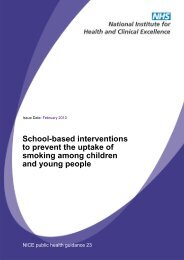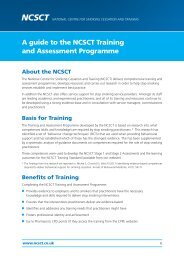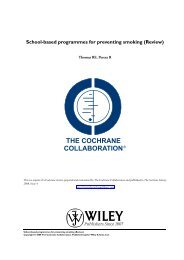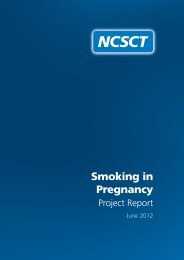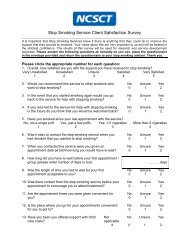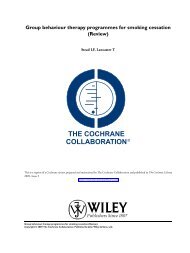Smoking and mental health - NCSCT
Smoking and mental health - NCSCT
Smoking and mental health - NCSCT
Create successful ePaper yourself
Turn your PDF publications into a flip-book with our unique Google optimized e-Paper software.
<strong>Smoking</strong> among people with <strong>mental</strong> disorders 2<br />
2.2.3 The Health Improvement Network<br />
THIN is a dataset of electronic primary care medical records, established in 2003<br />
by EPIC 6 licence holders of a historical part of the General Practice Research<br />
Database (GPRD). General practices using the Vision 17 electronic practice<br />
management software can choose to contribute their data to THIN, <strong>and</strong> data<br />
from contributing practices are uploaded electronically on a monthly basis.<br />
Ethics approval for the collection <strong>and</strong> use of these data has been granted by the<br />
NHS South-East Multicentre Research Ethics Committee. By September 2010,<br />
THIN contained records for almost 8 million patients from 495 practices<br />
throughout the UK; these patients are broadly representative of the UK<br />
population in terms of their age, sex, medical conditions <strong>and</strong> death rates. 18 THIN<br />
contains details of consultations with members of the primary <strong>health</strong>care team,<br />
investigation results, prescribed medications <strong>and</strong> lifestyle information such as<br />
smoking behaviour. Information is recorded using Read codes, a hierarchical<br />
dictionary of medical terminology. 19<br />
The data used in this chapter are derived from 2,493,085 patients aged 16 <strong>and</strong><br />
over who were registered with a THIN practice for the year from 1 July 2009 to<br />
30 June 2010. Patients with <strong>mental</strong> disorders were identified in two ways: Read<br />
codes were used to identify those with a record of one or more of several<br />
specified <strong>mental</strong> disorders during the study period, corresponding to ICD-10<br />
categories (Box 2.1), <strong>and</strong> British National Formulary (BNF) codes 20 were used<br />
to identify patients who had been prescribed a psychoactive medication<br />
(antipsychotic, antimanic, antidepressant or anxiolytic) during the study<br />
period.<br />
Patients who smoked during the study period were identified as those with a<br />
relevant smoking-related Read code recorded in their medical records during the<br />
study year. Patients were also classified as smokers if their smoking status was not<br />
recorded during the study period, but their last-recorded status before the start<br />
Box 2.1 ICD-10 codes for <strong>mental</strong> disorders identified in THIN<br />
patients<br />
F20–F29<br />
F31<br />
F32–F33<br />
F40–F48<br />
F50<br />
F60<br />
F90<br />
Schizophrenia, schizotypal <strong>and</strong> delusional disorders<br />
Bipolar affective disorder<br />
Depression<br />
Neurotic, stress-related <strong>and</strong> somatoform disorders<br />
Eating disorders<br />
Specific personality disorders<br />
Hyperkinetic disorders, including ADHD<br />
ADHD, attention deficit hyperactivity disorder; ICD-10, International Classification of<br />
Diseases, 10th revision; THIN, The Health Improvement Network.<br />
© Royal College of Physicians 2013 19




